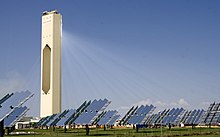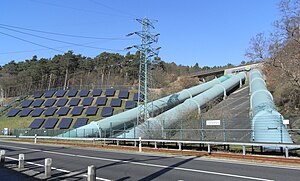Applications
Average insolation showing land area (small black dots) required to replace the world primary energy supply with solar electricity. 18 TW is 568 Exajoule (EJ) per year. Insolation for most people is from 150 to 300 W/m² or 3.5 to 7.0 kWh/m²/day.
Solar power has great potential, but in 2008 supplied less than 0.02% of the world's total energy supply
[citation needed]. There are many competing technologies, including 14 types of photovoltaic cells, such as thin film, monocrystalline silicon, polycrystalline silicon, and amorphous cells, as well as multiple types of concentrating solar power. It is too early to know which technology will become dominant.
[2]
The earliest significant application of solar cells was as a back-up power source to the Vanguard I satellite in 1958, which allowed it to continue transmitting for over a year after its chemical battery was exhausted.
[3] The successful operation of solar cells on this mission was duplicated in many other Soviet and American satellites, and by the late 1960s, PV had become the established source of power for them.
[4] Photovoltaics went on to play an essential part in the success of early commercial satellites such as Telstar, and they remain vital to the telecommunications infrastructure today.
[5]
The high cost of solar cells limited terrestrial uses throughout the 1960s. This changed in the early 1970s when prices reached levels that made PV generation competitive in remote areas without grid access. Early terrestrial uses included powering telecommunication stations, off-shore oil rigs, navigational buoys and railroad crossings.
[6] These off-grid applications accounted for over half of worldwide installed capacity until 2004.
[7]
Building-integrated photovoltaics cover the roofs of an increasing number of homes.
The 1973 oil crisis stimulated a rapid rise in the production of PV during the 1970s and early 1980s.
[8] Economies of scale which resulted from increasing production along with improvements in system performance brought the price of PV down from 100 USD/watt in 1971 to 7 USD/watt in 1985.
[9] Steadily falling oil prices during the early 1980s led to a reduction in funding for photovoltaic R&D and a discontinuation of the tax credits associated with the Energy Tax Act of 1978. These factors moderated growth to approximately 15% per year from 1984 through 1996.
[10]
Since the mid-1990s, leadership in the PV sector has shifted from the US to Japan and Europe. Between 1992 and 1994, Japan increased R&D funding, established net metering guidelines, and introduced a subsidy program to encourage the installation of residential PV systems.
[11] As a result, PV installations in the country climbed from 31.2 MW in 1994 to 318 MW in 1999,
[12] and worldwide production growth increased to 30% in the late 1990s.
[13]







